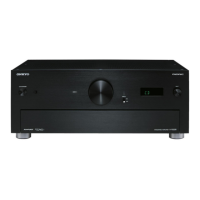5
En
Technologies
The A-9000R employs a host of proprietary
Onkyo technologies to ensure optimal audio
performance.
Since the advent of digital audio, the values of
S/N (signal-to-noise) ratio have risen
significantly. However, it is also recognized that
in terms of perceived S/N, analog audio sources
are not inferior to digital sources.
Generally, S/N measures the ratio when sound
is and not produced, but takes no account of the
noise generated during sound reproduction.
For a long time, Onkyo has focused and made
extensive research on the S/N when sound is
produced (dynamic S/N). Using a mechanism
that captures the noise beyond audible range, it
has been possible to determine that both
dynamic S/N and perceived S/N aggravate
during music reproduction.
Although frequencies above 20 kHz are beyond
human hearing, it is well known that a beat can
be perceived if different signals are overlapped
at such frequencies.
During the analog audio era, no significant
signals were entering beyond the audible range.
However, the digital era has made recording
beyond the audible range possible and the
generated beat is now perceivable.
With Onkyo’s DIDRC technology, a new
approach is introduced which prevents such
beat from penetrating the audible range.
Conventional amplifiers make extensive use of
negative feedback (NFB), whereby part of the
output signal is re-input in order to improve the
S/N ratio across a wide frequency range.
However, too much NFB makes a system
susceptible to counter-electromotive force from
the speakers, resulting in a drop in perceived
sound quality. To avoid this, Onkyo focuses on
improving the frequency response and reducing
distortion, without relying so much on NFB.
We use a low negative-feedback design
incorporating audiophile-grade, close-tolerance
components, to achieve a frequency response,
out to 100 kHz.
If an amplifier’s ground potential (voltage)
fluctuates during playback, noise is likely to
result. In an open-loop circuit design, where all
circuits wire connected to the power supply via
a single loop (as on many amplifiers), the noise
is compounded. To avoid this, the A-9000R
employs a sophisticated closed-circuit design in
which each circuit has a separate link to the
power supply. This helps to cancel individual
circuit noise and keep the ground potential free
of distortion.
When an amplifier outputs an audio signal, the
connected speakers accumulate energy, reflex,
and send energy back to the amplifier. The
amplifier must then immediately cancel the
speakers’ reflex energy and instantaneously
send out the next signal. The same high current
required to achieve this is also necessary to
handle speaker impedance, fluctuations, which
can force an amplifier to provide four to six
times its usual current load. The A-9000R’s
instantaneous current capability ensures that
audio output is not affected by power
limitations.
Power devices for the left and right channels of
the A-9000R are aligned symmetrically. Each
channel has the same electrical and structural
design, and signal pathways are uniform in
length. This helps to minimize errors in
stereophonic playback.
1. A WRAT (Advanced Wide Range
Amplifier Technology)
– DIDRC (Dynamic Intermodulation
Distortion Reduction Circuitry)
– Low Negative-Feedback Design
– Closed Ground-Loop Circuits
– HICC (High Instantaneous-Current
Capability)
– Symmetrical Twin-Monaural
Construction

